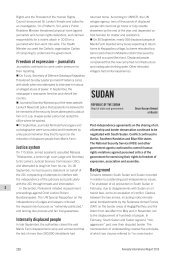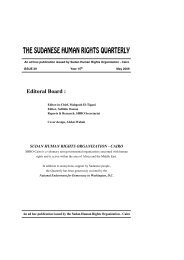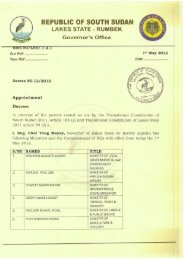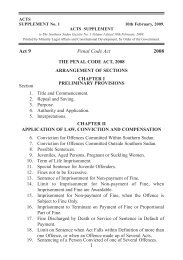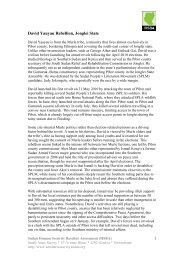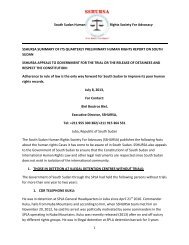The Distribution of Iranian Ammunition in Africa - Conflict Armament ...
The Distribution of Iranian Ammunition in Africa - Conflict Armament ...
The Distribution of Iranian Ammunition in Africa - Conflict Armament ...
You also want an ePaper? Increase the reach of your titles
YUMPU automatically turns print PDFs into web optimized ePapers that Google loves.
CASE STUDIESwere marked with yellow/gold letter<strong>in</strong>g <strong>in</strong>dicat<strong>in</strong>gthe quantity <strong>of</strong> ammunition, the calibre, lot numberand year <strong>of</strong> manufacture. Although the sensitivesecurity environment prevented photography <strong>of</strong> thepackag<strong>in</strong>g, 15 the bags were identical <strong>in</strong> constructionand mark<strong>in</strong>g to <strong>Iranian</strong> ammunition ‘battle bags’later found elsewhere on the cont<strong>in</strong>ent (see thecases presented below).<strong>The</strong> Small Arms Survey study concluded thatKenyan security forces were the primary source<strong>of</strong> the (then-unidentified) <strong>Iranian</strong> 7.62 x 39 mmammunition circulat<strong>in</strong>g <strong>in</strong> the region—specificallythe Kenya Police and Kenya Police Reserves.Evidence for these assertions <strong>in</strong>cluded thefollow<strong>in</strong>g:In 2008 <strong>Iranian</strong>-manufactured ammunition <strong>of</strong> thetype illustrated <strong>in</strong> Image 8 comprised 70 per cent<strong>of</strong> sampled 7.62 x 39 mm cartridges <strong>in</strong> servicewith the Kenya Police and Kenya Police Reserves.<strong>The</strong> study observed first-hand the Kenya Policesupply<strong>in</strong>g this type <strong>of</strong> ammunition to armedTurkana civilians <strong>in</strong> 2007 and 2008.Reports by those supplied with the ammunitionconfirmed that the Kenya Police and Kenya PoliceReserves had distributed it.<strong>The</strong> prevalence <strong>of</strong> this type <strong>of</strong> ammunitiondim<strong>in</strong>ished at greater distances from Kenya (andfrom the Kenya Police and Kenya Police Reservesthat supplied it). 16Although not recognised <strong>in</strong> 2008 as hav<strong>in</strong>gorig<strong>in</strong>ated <strong>in</strong> Iran, it is clear that the Government<strong>of</strong> Kenya imported very large quantities <strong>of</strong> <strong>Iranian</strong>ammunition—probably <strong>in</strong> the range <strong>of</strong> millions <strong>of</strong>rounds.Analysis <strong>of</strong> the date marks applied to cartridges<strong>in</strong>dicate production <strong>in</strong> the years 2001, 2002 and2003, with 97 per cent <strong>of</strong> the cartridges bear<strong>in</strong>g2003 date marks. A logical conclusion is that thecartridges cannot have been supplied prior to thedate <strong>of</strong> manufacture (2001), nor can they have beensupplied after the date they were observed (2008).Moreover, given that the majority <strong>of</strong> cartridges datefrom 2003 and that large-scale observation began<strong>in</strong> 2006, there are some grounds for conclud<strong>in</strong>g thatthe Government <strong>of</strong> Kenya acquired the ammunitionbetween 2003 and 2006. This conclusion is arguablylent greater weight by the fact that UN SecurityCouncil prohibited the export <strong>of</strong> <strong>Iranian</strong> militarymateriel <strong>in</strong> March 2007, which should have deterreddirect Kenyan ammunition acquisition from Iranafter that date. 17However, these observations shed little light onthe actual circumstances <strong>of</strong> Kenya’s acquisition<strong>of</strong> the ammunition. Without evidence to thecontrary, supply by a third party (other than Iran)cannot be excluded. However, the time betweenmanufacture and supply (plausibly as little as threeyears) would suggest a very rapid series <strong>of</strong> transfersbetween three parties—i.e. export from Iran to athird country and subsequent re-export to Kenya.Requests for clarification made to the Government<strong>of</strong> Kenya at the time <strong>of</strong> the <strong>in</strong>itial <strong>in</strong>vestigation ands<strong>in</strong>ce rema<strong>in</strong> unanswered. 18DARFUR, SOUTHERN SUDAN AND SOUTH SUDAN, 2006–12<strong>Iranian</strong> ammunition is <strong>in</strong> service with Khartoumbackedforces <strong>in</strong> the Darfur region <strong>of</strong> Sudan. It isalso <strong>in</strong> service with SAF troops operat<strong>in</strong>g on theborder with South Sudan. Although <strong>in</strong>vestigationshave not documented supplies <strong>of</strong> <strong>Iranian</strong>ammunition to Khartoum-backed militias <strong>in</strong> SouthSudan, they have identified <strong>Iranian</strong> weapons <strong>in</strong> allthree regions—Darfur, southern Sudan 19 and SouthSudan.<strong>The</strong>re is also grow<strong>in</strong>g evidence to suggest thatthe Government <strong>of</strong> Sudan manufactures weapons<strong>of</strong> <strong>Iranian</strong> design, operates weapon productionfacilities with <strong>Iranian</strong> assistance and supplies<strong>Iranian</strong>-manufactured weapons to forces allied to it<strong>in</strong> the region.Work<strong>in</strong>g <strong>in</strong> conjunction with <strong>in</strong>dependent<strong>in</strong>vestigators, <strong>Conflict</strong> <strong>Armament</strong> Research hasdocumented two types <strong>of</strong> <strong>Iranian</strong> ammunition <strong>in</strong>service with Khartoum-backed militia forces <strong>in</strong>Darfur and southern Sudan. <strong>The</strong> first type is 7.62 x39 mm <strong>in</strong> calibre and is identical <strong>in</strong> construction tothe examples documented elsewhere <strong>in</strong> this report(see Image 9).<strong>The</strong> second type <strong>of</strong> ammunition, documented <strong>in</strong>use <strong>in</strong> Darfur and southern Sudan, is 7.62 x 54Rmm <strong>in</strong> calibre (see Image 10). <strong>The</strong> cartridge isalso identical to <strong>Iranian</strong> ammunition identifiedelsewhere <strong>in</strong> this report. A third cartridge is 12.7 x108 mm <strong>in</strong> calibre, resembles <strong>Iranian</strong>-manufactured24<strong>Conflict</strong> <strong>Armament</strong> Research<strong>The</strong> <strong>Distribution</strong> <strong>of</strong> <strong>Iranian</strong> <strong>Ammunition</strong> <strong>in</strong> <strong>Africa</strong>: Evidence from a N<strong>in</strong>e-country Investigation



